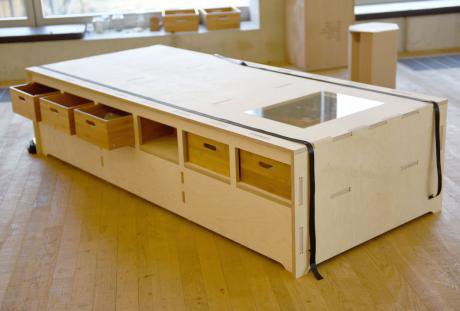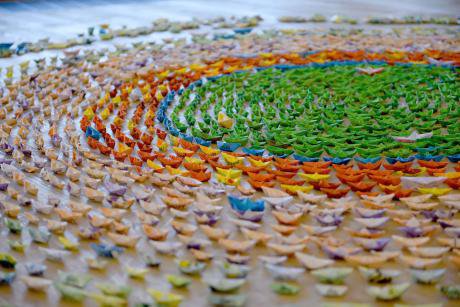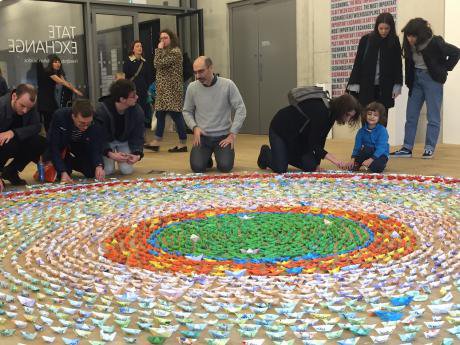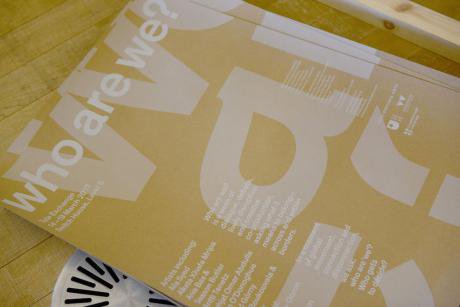

‘Refugees Welcome’ located outside Tate Modern. Photo: Marcia Chandra. All rights reserved."What can be expected of…[art] in politically fraught times?" asks reviewer Hili Perlson, commenting on the recently launched Istanbul Biennale (running from 15 September to 12 November 2017). With its open-ended yet pointed theme, ‘A Good Neighbour’, the Biennale invited artists and audiences to reflect on the tenuous concept of ‘co-existence’ together with questions of otherness, identity and belonging. Predictably this Biennale received much commentary given the backdrop of current human rights violations in Turkey plus ongoing media censorship. The notion of what is ‘politically fraught’ has taken on disturbingly local dimensions across the exhibition space that is Istanbul.
Biennales and art fairs seldom remain unscathed. Their warp and weft are dependent on the hospitality and political fabric of the host city and its diverse inhabitants. Yanis Varoufakis’s fierce critique of documenta 14 illustrates this curatorial challenge in his adamant refusal to separate grand themes – no matter how progressive-sounding - from the everyday, harsh realities of local economies: "documenta took a great deal more from Athens", says Varoufakis, "from both its private and public sector – than it gave. Adding the veneer of a left-wing narrative against neoliberalism to a purely extractive neocolonial project that’s framed as a gift to Greece is adding insult to injury". For Varoufakis, the space between artist and audience at documenta 14 was overshadowed by a complex set of colonial and neocolonial tradeoffs, and, in this case, ‘art’ and the geo-political apparatus driving it, was hardly a benevolent mediator.
"documenta took a great deal more from Athens, from both its private and public sector, than it gave." – Yanis Varoufakis
Varoufakis’s invocation of a more ‘equal’ exchange between curators, artists, international audiences, local Athenians and civic infrastructures begs the question of whether structural inequity is inevitable despite attempts to redress the balance through democratic aspirations of collaboration, participation and co-production.
This was also a question and challenge for the recent Who Are We? project at Tate Exchange, from 14-19 March 2017. Tilting the axis to a politics of dialogue – admittedly on a much less grand scale than a city-wide Biennale or International Quinquennial – we invited artists and audiences to take part in a series of exchanges and performative conversations about rights, identity, migration, global displacement and citizenship, in a popular context particularly coloured by Brexit.
Who Are We? began as an ambitious experiment, as several Tate Exchange associates, such as ourselves at Counterpoints Arts and The Open University, who together with the universities of Loughborough and Warwick formed a collaborative arts platform that was made richer with support from Universal Design Studio and Graphic Thought Facility and contributions from Goldsmiths University of London and the Stuart Hall Foundation. More ‘programme’ than ‘exhibition’, twenty-two artists contributed to a week aimed to evoke and provoke lively discussions and co-productions – to create something new out of an arguably exhausted language of politics and public policy. To this end, Who Are We? was and is in its fothcoming iteration (in 2017/2018) asking what it means to belong – across and within borders. In a moment of global movement, connection and dis-connection, the project repeatedly asks: who are ‘we'? Who gets to decide?
A primary aim of Who Are We? was to eschew the white cube gallery setting and create a hybrid library/lab space – allowing visitors to linger and engage with content and artists. With light installations, site-specific work, live art, learning labs, screenings, workshops and seminars, the programme was designed to encourage open debate and dialogue. We set out – at least on paper – to critically navigate the connections and tensions between arts, activism, audiences, advocacy and academia, seeing how and where social exchange or change might or might not happen along the way.

Who Are We? Banner located at entrance. Co-designed by Graphic Thought Facility and Universal Design Studio. Photo: Cathrin Walczyk. All rights reserved. But it’s often one thing in theory and quite another in practice. In our ongoing work at Counterpoints Arts we straddle the fluid lines between commissioning, mentoring, curation, production and learning; and, at the same time, we encourage and facilitate collaboration and partnerships across different sectors. The question of what to ‘expect’ from art and artists is not easily answered; nor is it easy to discern where and how social change comes about. Who Are We? was and is not heavy-handed in its prescriptions. Art as a magical salve or a vehicle for social change, when loosely bandied about, remains an empty slogan.
That said, many of the artists in Who Are We? with whom we work at Counterpoints Arts have long stepped into the imaginative breach and vacuum where politics appears to have failed. What’s exciting is that it’s almost impossible to pin these artists down using the usual art-speak and art-formulae. Much of the work was and is fueled by what playwright, Eve Ensler, calls ‘artivism’ – "the ingredients of activism… charged with the wild creations of art". Somewhat romantically put yet Ensler is on to something: ‘artivism’, she says, is ‘where [the] edges are pushed, imagination is freed, and a new language emerges altogether’.
Two artists, in particular, (among others at Who Are We?) are radically pushing at these edges.
‘Refugees Welcome’ by Alketa Xhafa Mripa, took the form of a Luton tail lift van and was parked outside Tate Modern. Having this work located outside Tate Exchange was an important marker. We wanted to make a public statement and to draw people in and up to the 5th Floor. Otherwise how might people know about the programme given the vastness of the building and its capacity to absorb and distract visitors.

‘Refugee Welcome’ Interior of Van. Photo: Marcia Chandra. All rights reserved.There’s gentility and steeliness to ‘Refugees Welcome’ and its simplicity is deceiving. Mripa invites people into the van and evokes memories of being warmly welcomed from Kosovo in the late 1990’s as a prompt for conversation; but is this performance, agitprop, site-specific installation or activism? She embraces all these labels and more. The symbolism of the van is itself a statement. It’s a folksy living room – kitsch in its choice of furniture yet stark in its use of metal hooks with letters hanging on each side, spelling out ‘Refugees Welcome’. Evoking perilous passage across borders and deadly claustrophobia, the anomaly of the Union Jack on the back wall – framed like tapestry or wallpaper – is offset by the neon sign spelling ‘Hope’. In each object we read playfulness, irony, and metaphor not least of all triggered by the ‘tea for two’ props providing a conduit for conversations.
Since Who Are We?, Mripa has been traveling around the UK to different locations – literally taking her show on the road. ‘Have a cup of tea with a refugee’ is an easy catch phrase for journalists covering the installation. Yet for Mripa the seeming banality of the tea ritual speaks volumes about British hospitality and its recent, even cruel demise - questioning in each performance what has happened to that collective welcome and widespread hospitality. Little by little, conversations in the Refugees Welcome van paint a picture of people’s fears, anxieties and hopeful desires about what it means to live in Britain or call oneself ‘British’ in Brexit times.

‘Refugees Welcome’ parked at Minster, York. Photo: Nelli Stavropoulou. All rights reserved.Almost none of the work at Who Are We? was or is easily consumed; instead objects and installations acted as triggers for public engagement.

Natasha Davis’s Object co-designed with Davis and Universal Art Studio. Photo: Cathrin Walczyk. All rights reserved.In some instances, the political meaning was overtly evident. Bern O’Donoghue’s installation, Dead Reckoning, literally performed Santiago Zabala’s argument in Why Only Art Can Save Us Now: Aesthetics and the Absence of Emergency. ‘Instead of inviting us to contemplate its beauty, a work calls us to respond, react and become involved’).

‘Dead Reckoning’ installation shot. Photo: Marcia Chandra. All rights reserved.Dead Reckoning is heart-achingly moving. Day after day O’Donoghue laid out hundreds of miniature origami boats representing the lives of missing migrants lost in the Mediterranean en route to Europe. These small objects strewn across the gallery floor in the form of a participatory installation made an incremental statement. Visitors were invited into the process of crafting the artwork: each tiny boat represented a migrant lost at sea and an individual’s life story - transforming the abstract statistics and data into something embodied and human. Co-production was dependent on exchanges facilitated by the artist who persistently asks questions and dispels myths – not letting us off the hook. O’Donoghue managed to steadily steer the sensational media narratives about ‘refugees’ and displacement into a more intimate space of learning and solidarity.

‘Dead Reckoning’ Installation shot: Photo: Marcia Chandra. All rights reserved.Like Mripa, Dead Reckoning is entirely reliant on participation in order to make sense. And, echoing Zabala, the installation worked at a visceral and ‘existential level’. As one participant puts it: ’It’s only when you put these [boats] out that you realise that this is a person. It really concentrates the mind to think that it is actually somebody who drowned’.
It’s possible to calculate in quantifiable terms the impact of Who Are We?. Footfall metrics approximate 5,300 visitors throughout the week with on average a forty-minute engagement or stay on the floor. The quality of the exchanges is harder to evaluate yet fascinating to observe in the accompanying short films shot by filmmaker, Marcia Chandra, throughout the week and featured here. O’Donoghue’s active journeying across the roles of ‘Artist, Educator and Facilitator’ evokes the potential value and sliding scale of exchange and of what to expect, in part, from ‘art’ in these tumultuous times. For as she puts it: ‘It is in the small and the simple where human scale may be found, where one mind is changed, and we begin to change the world’.
Did we challenge structural inequity? Who Are We? is a much more modest endeavor than the great global beast that is Documenta 14 caustically critiqued by Varoufakis. At very best we began to open up spaces for difficult conversations, since many of the artists, activists and academics at Who Are We? are committed to drawing audiences into work exploring identity, citizenship, displacement, rights and belonging. The sustained dialogue which developed between artists and academics opened up unique avenues and ways of reciprocal thinking and sharing/learning in the lead-up to the programme. This coupling of artists with academic partners - whilst not overtly evident in the final physical curation – played a pivotal role in the exploration of multiple, parallel research themes and agendas underpinning the work (instances of these dialogues are published in this series). Arguably the added value of cross-sector exchange resulted in a shared commitment to engage wider audiences through a range of compelling art forms and media. Reviewer, Chrissie Tiller walks us through the degrees of social and public impact in her participant-observation of the eclectic richness of installations and participatory approaches.
Like all experiments Tate Exchange is in its infancy and thus productively flawed. It has, however, opened up opportunities for collective exploration via a testing ground for ideas and projects. Detractors will rightly say that such well-intentioned experiments about art and social change remain separate from the wider infrastructure of Tate Modern - indeed only happen on the 5th Floor. Perhaps one of the biggest challenges in Year 2 for Who Are We? at Tate Exchange will be to imagine the creative methodologies in other gallery spaces across the Tate. To encounter them, as Tiller says ‘curated alongside Wolfgang Tillmans’ critique of Blair, or Rauschenberg’s images of late 20th century political turmoil?’. The challenge will also be to situate the work beyond the boundaries of Tate Exchange and Metropolitan London.

Tate Exchange: Who Are We? poster. Photo Cathrin Cathrin Walczyk. All rights reserved.Counterpoints Arts is currently working with several of the artists who contributed to Who Are We? scaling up and transforming concepts and content to engage with a wider geographically spread demographic and audience.
This article is published as part of an editorial partnership between openDemocracy, The Open University and Counterpoints Arts to reanimate the Tate Exchange project in which academics and artists together ask who – during a time when the lines marking out citizens, borders and nations are being redrawn, or drawn more starkly – 'we' are, and who gets to decide.
Read more
Get our weekly email









Comments
We encourage anyone to comment, please consult the oD commenting guidelines if you have any questions.